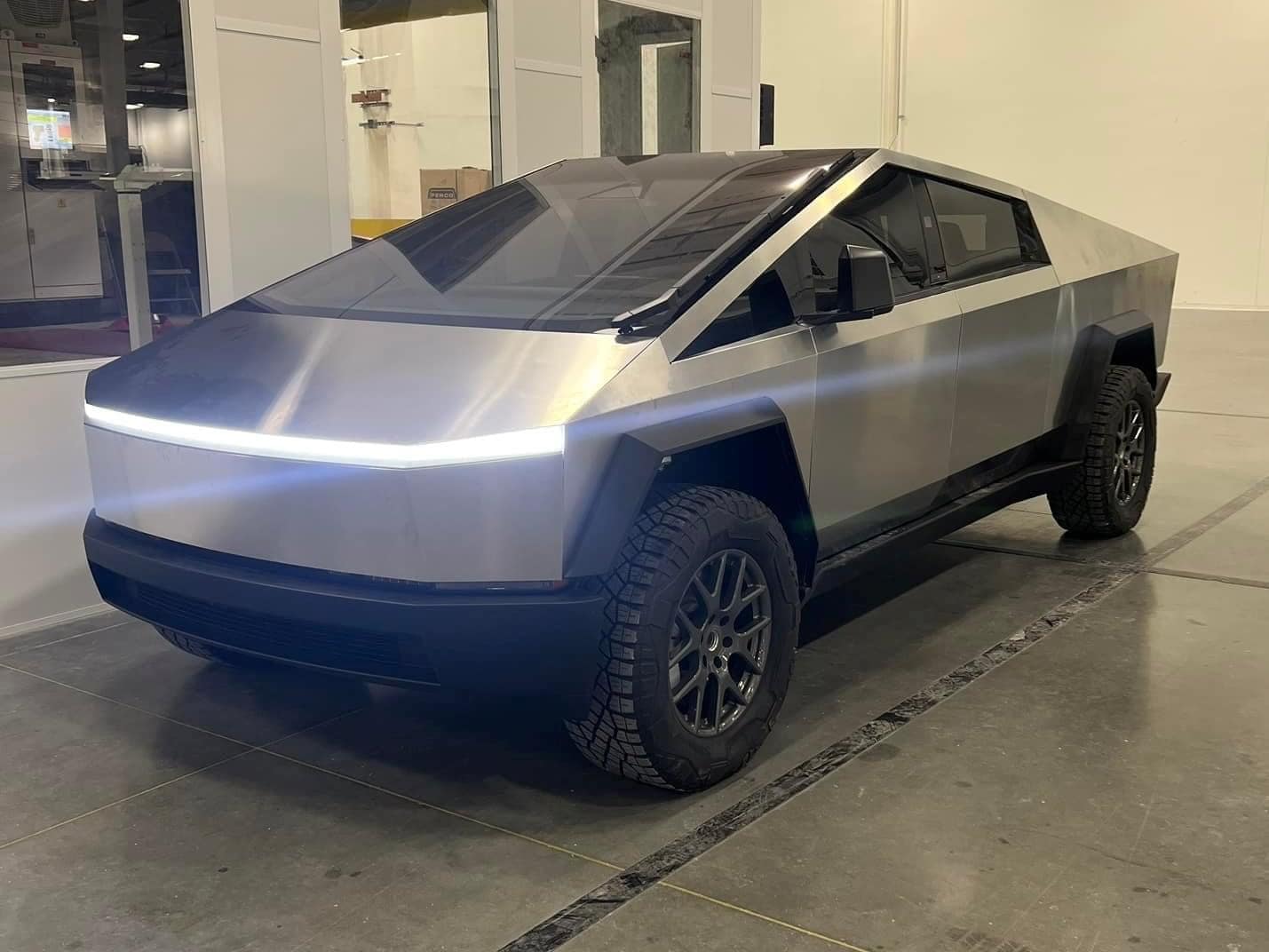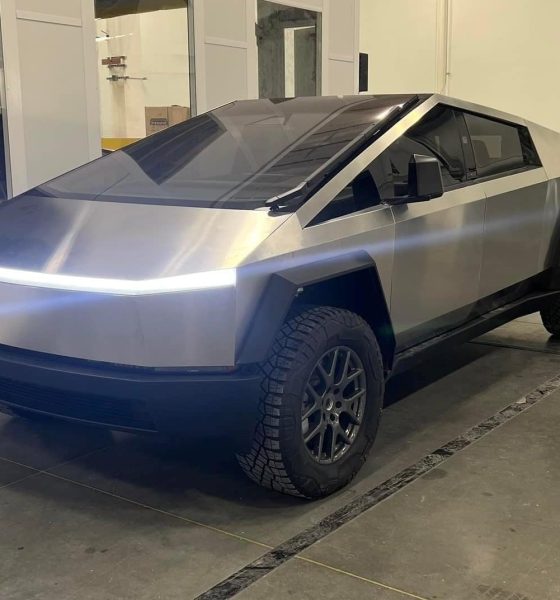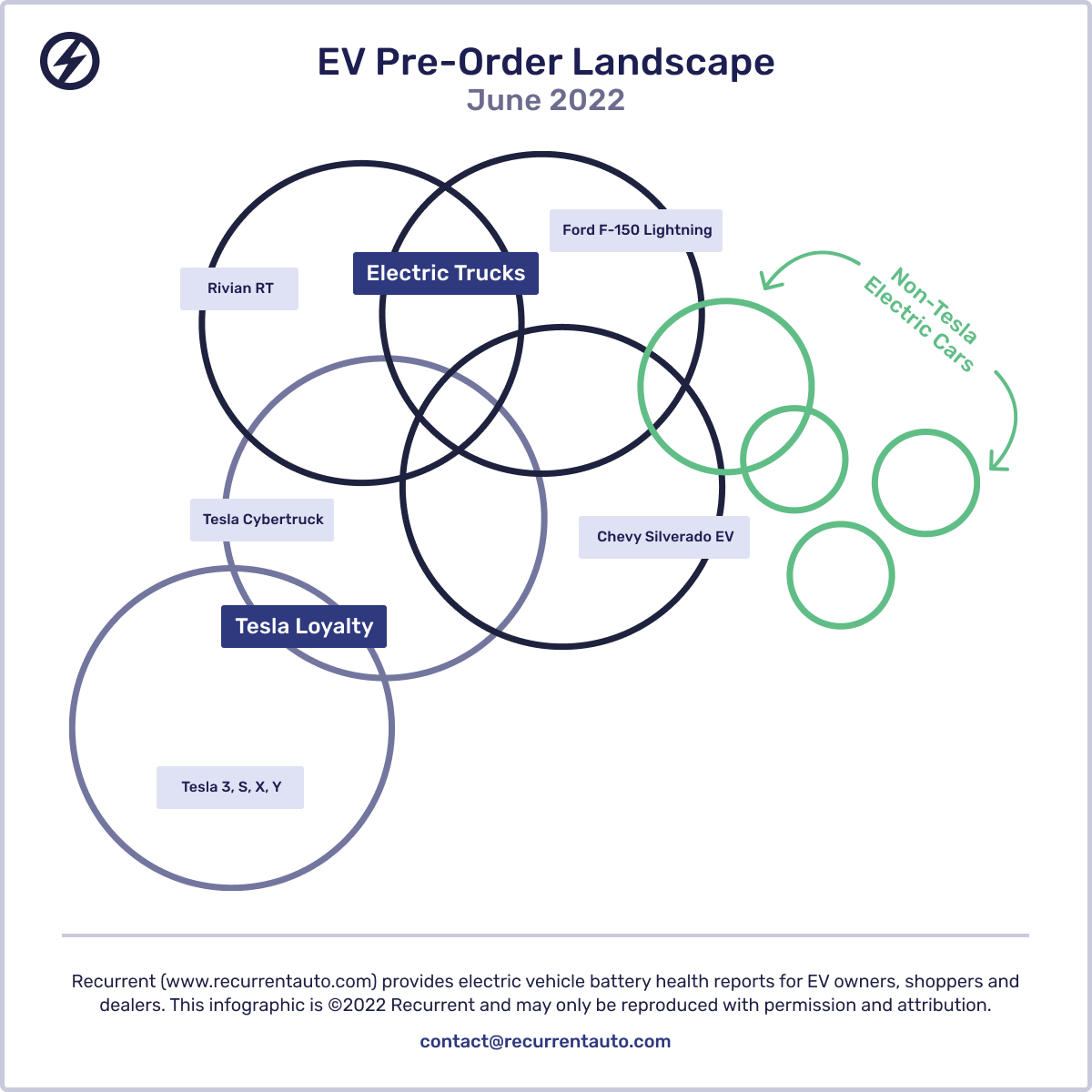

News
Electric pickup buyers hold multiple reservations as delivery date uncertainty looms: survey
With so many electric pickups set to hit the market in the coming years, consumers are playing their hands by holding reservations on multiple EV trucks due to the uncertainty of when they might be delivered.
A new survey from Recurrent shows that “about 89% of Tesla Cybertruck reservations overlap with another truck pre-order, and 100% of Ford F-150 and Chevrolet Silverado reservations also pre-ordered another vehicle on this list. ”
It is no secret a major focus of many electric automakers in 2021 and 2022 was the EV pickup. With trucks being such a popular body style in the United States and elsewhere, companies were fending to offer the first EV pickup, but also the most effective one. While Rivian’s R1T was the first electric pickup on the market, the GMC Hummer EV joined the list shortly after. However, notable newcomers and worthy opponents are coming, as the Tesla Cybertruck and Chevrolet Silverado EV are both expected to hit production lines in the next year. A breakdown of how many reservations each truck has, and how prospective EV truck buyers are playing their multiple pre-orders, shows the anticipation for the emergence of the electric pickup market.
“We knew that 2022 would be the year of the electric truck, and the year has not disappointed us, at least as far as pre-orders go,” Scott Case, CEO and co-founder of Recurrent, said. “But I’m also taking pre-order number claims by manufacturers with a grain of salt, because clearly not all of those orders are solid. Shoppers should not be scared off by long pre-order waits if they know the vehicle you want.”
It has been reported on numerous occasions that the Tesla Cybertruck has accumulated a massive number of pre-orders: 1.27 million+, according to Recurrent’s research. The F-150 Lightning is second with 200,000 pre-orders, and the Rivian R1T and R1S and Hummer EV have 90,000 and 65,000, respectively.
However, the breakdown of how these pre-orders are being played is most interesting. Recurrent surveyed over 200 EV shoppers in a partnership with AAA Washington to see what EVs buyers have pre-ordered and which they intend to actually purchase. The research showed that Tesla vehicles have 100 percent order fulfillment, while other vehicles, like the Chevy Silverado EV, only had a 20 percent fulfillment rate.
“In the case of Tesla, there is a non-refundable order fee that may weed out some impulsive reservations, as well as the knowledge that the market is hot enough to resell your order before you even take delivery,” the study said. Recurrent attributed the outliers above to three factors:
- Uncertainty on delivery time – or delivery at all – may cause some shoppers to modulate their enthusiasm for certain vehicles. Of course, the Tesla Cybertruck, with its seemingly infinite production delays, comes to mind here.
- Refundable reservations mean that customers can express interest in many cars and make the decision when they see when, and what, they can actually drive off in.
- With all the buzz around electric vehicles, manufacturers may be incentivized to make reservations easy for shoppers in order to pump up their numbers, even if these reservations don’t all turn into sales
In general, however, EV truck buyers are more likely to have multiple reservations. Recurrent says the strategy of over-ordering allows buyers to keep their options open, especially as production and delivery dates have not yet been solidified by the manufacturers, which gives the reservations holders more time to analyze their decisions. However, 89 percent of Cybertruck reservations overlap with another EV truck order, while 100 percent of Ford F-150 Lightning and Chevy Silverado EV orders are paired with another vehicle on the list Recurrent put together.
Credit: Recurrent
Additionally, the study found that Tesla brand loyalty runs deep. “Recurrent found that many families have gone all-in on Tesla. Around 50% of those who have reserved both a Telsa Cyber Truck and a Tesla car model plan to redeem both,” it said.
Tesla reservations do not seem to overlap with other brands, which would align with the company’s history of brand loyalty. “If you’ve reserved a Ford F-150, Rivian, or Chevy Silverado, chances are good that you may also have reserved a Tesla Cybertruck,” Recurrent’s study added. “But, if you’re interested in any of the new, non-truck options on this list, there is virtually no overlap with the Tesla brand. There is a clear chasm between non-Tesla cars and Tesla reservations.”
I’d love to hear from you! If you have any comments, concerns, or questions, please email me at joey@teslarati.com. You can also reach me on Twitter @KlenderJoey, or if you have news tips, you can email us at tips@teslarati.com.

Elon Musk
Elon Musk and Tesla AI Director share insights after empty driver seat Robotaxi rides
The executives’ unoccupied tests hint at the rapid progress of Tesla’s unsupervised Robotaxi efforts.

Tesla CEO Elon Musk and AI Director Ashok Elluswamy celebrated Christmas Eve by sharing personal experiences with Robotaxi vehicles that had no safety monitor or occupant in the driver’s seat. Musk described the system’s “perfect driving” around Austin, while Elluswamy posted video from the back seat, calling it “an amazing experience.”
The executives’ unoccupied tests hint at the rapid progress of Tesla’s unsupervised Robotaxi efforts.
Elon and Ashok’s firsthand Robotaxi insights
Prior to Musk and the Tesla AI Director’s posts, sightings of unmanned Teslas navigating public roads were widely shared on social media. One such vehicle was spotted in Austin, Texas, which Elon Musk acknowleged by stating that “Testing is underway with no occupants in the car.”
Based on his Christmas Eve post, Musk seemed to have tested an unmanned Tesla himself. “A Tesla with no safety monitor in the car and me sitting in the passenger seat took me all around Austin on Sunday with perfect driving,” Musk wrote in his post.
Elluswamy responded with a 2-minute video showing himself in the rear of an unmanned Tesla. The video featured the vehicle’s empty front seats, as well as its smooth handling through real-world traffic. He captioned his video with the words, “It’s an amazing experience!”
Towards Unsupervised operations
During an xAI Hackathon earlier this month, Elon Musk mentioned that Tesla owed be removing Safety Monitors from its Robotaxis in Austin in just three weeks. “Unsupervised is pretty much solved at this point. So there will be Tesla Robotaxis operating in Austin with no one in them. Not even anyone in the passenger seat in about three weeks,” he said. Musk echoed similar estimates at the 2025 Annual Shareholder Meeting and the Q3 2025 earnings call.
Considering the insights that were posted Musk and Elluswamy, it does appear that Tesla is working hard towards operating its Robotaxis with no safety monitors. This is quite impressive considering that the service was launched just earlier this year.
Elon Musk
Starlink passes 9 million active customers just weeks after hitting 8 million
The milestone highlights the accelerating growth of Starlink, which has now been adding over 20,000 new users per day.

SpaceX’s Starlink satellite internet service has continued its rapid global expansion, surpassing 9 million active customers just weeks after crossing the 8 million mark.
The milestone highlights the accelerating growth of Starlink, which has now been adding over 20,000 new users per day.
9 million customers
In a post on X, SpaceX stated that Starlink now serves over 9 million active users across 155 countries, territories, and markets. The company reached 8 million customers in early November, meaning it added roughly 1 million subscribers in under seven weeks, or about 21,275 new users on average per day.
“Starlink is connecting more than 9M active customers with high-speed internet across 155 countries, territories, and many other markets,” Starlink wrote in a post on its official X account. SpaceX President Gwynne Shotwell also celebrated the milestone on X. “A huge thank you to all of our customers and congrats to the Starlink team for such an incredible product,” she wrote.
That growth rate reflects both rising demand for broadband in underserved regions and Starlink’s expanding satellite constellation, which now includes more than 9,000 low-Earth-orbit satellites designed to deliver high-speed, low-latency internet worldwide.
Starlink’s momentum
Starlink’s momentum has been building up. SpaceX reported 4.6 million Starlink customers in December 2024, followed by 7 million by August 2025, and 8 million customers in November. Independent data also suggests Starlink usage is rising sharply, with Cloudflare reporting that global web traffic from Starlink users more than doubled in 2025, as noted in an Insider report.
Starlink’s momentum is increasingly tied to SpaceX’s broader financial outlook. Elon Musk has said the satellite network is “by far” the company’s largest revenue driver, and reports suggest SpaceX may be positioning itself for an initial public offering as soon as next year, with valuations estimated as high as $1.5 trillion. Musk has also suggested in the past that Starlink could have its own IPO in the future.
News
NVIDIA Director of Robotics: Tesla FSD v14 is the first AI to pass the “Physical Turing Test”
After testing FSD v14, Fan stated that his experience with FSD felt magical at first, but it soon started to feel like a routine.

NVIDIA Director of Robotics Jim Fan has praised Tesla’s Full Self-Driving (Supervised) v14 as the first AI to pass what he described as a “Physical Turing Test.”
After testing FSD v14, Fan stated that his experience with FSD felt magical at first, but it soon started to feel like a routine. And just like smartphones today, removing it now would “actively hurt.”
Jim Fan’s hands-on FSD v14 impressions
Fan, a leading researcher in embodied AI who is currently solving Physical AI at NVIDIA and spearheading the company’s Project GR00T initiative, noted that he actually was late to the Tesla game. He was, however, one of the first to try out FSD v14.
“I was very late to own a Tesla but among the earliest to try out FSD v14. It’s perhaps the first time I experience an AI that passes the Physical Turing Test: after a long day at work, you press a button, lay back, and couldn’t tell if a neural net or a human drove you home,” Fan wrote in a post on X.
Fan added: “Despite knowing exactly how robot learning works, I still find it magical watching the steering wheel turn by itself. First it feels surreal, next it becomes routine. Then, like the smartphone, taking it away actively hurts. This is how humanity gets rewired and glued to god-like technologies.”
The Physical Turing Test
The original Turing Test was conceived by Alan Turing in 1950, and it was aimed at determining if a machine could exhibit behavior that is equivalent to or indistinguishable from a human. By focusing on text-based conversations, the original Turing Test set a high bar for natural language processing and machine learning.
This test has been passed by today’s large language models. However, the capability to converse in a humanlike manner is a completely different challenge from performing real-world problem-solving or physical interactions. Thus, Fan introduced the Physical Turing Test, which challenges AI systems to demonstrate intelligence through physical actions.
Based on Fan’s comments, Tesla has demonstrated these intelligent physical actions with FSD v14. Elon Musk agreed with the NVIDIA executive, stating in a post on X that with FSD v14, “you can sense the sentience maturing.” Musk also praised Tesla AI, calling it the best “real-world AI” today.








